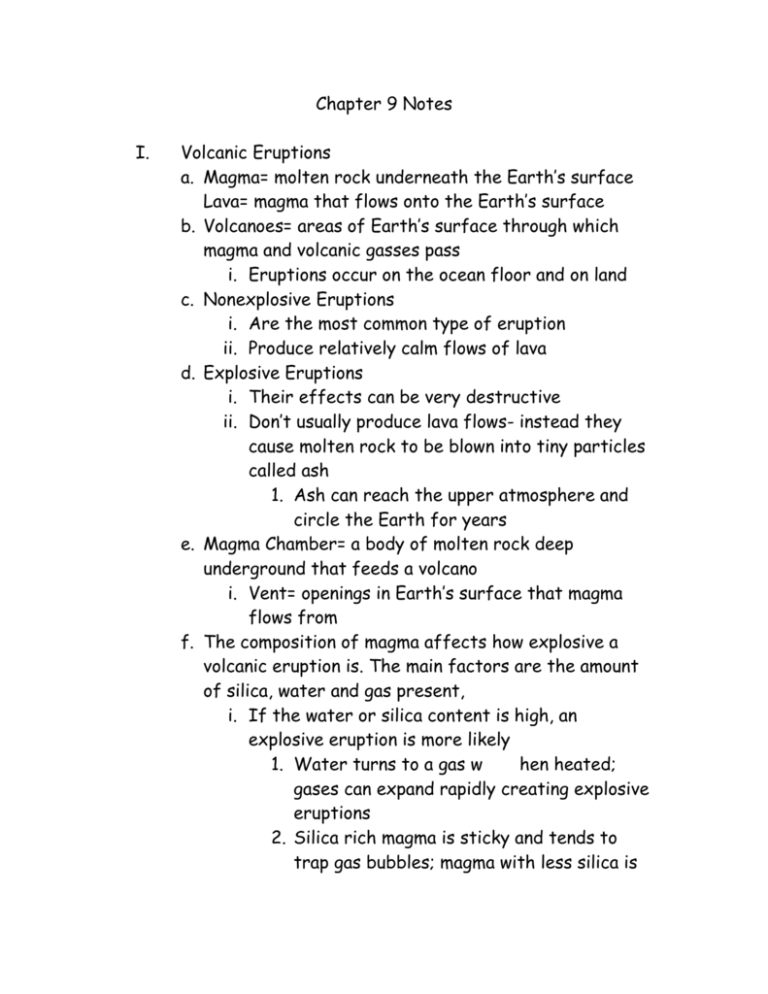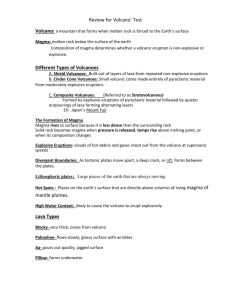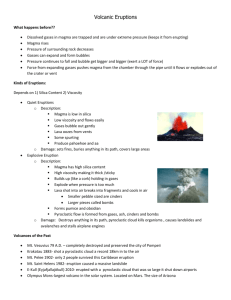Chapter 9 Notes
advertisement

Chapter 9 Notes I. Volcanic Eruptions a. Magma= molten rock underneath the Earth’s surface Lava= magma that flows onto the Earth’s surface b. Volcanoes= areas of Earth’s surface through which magma and volcanic gasses pass i. Eruptions occur on the ocean floor and on land c. Nonexplosive Eruptions i. Are the most common type of eruption ii. Produce relatively calm flows of lava d. Explosive Eruptions i. Their effects can be very destructive ii. Don’t usually produce lava flows- instead they cause molten rock to be blown into tiny particles called ash 1. Ash can reach the upper atmosphere and circle the Earth for years e. Magma Chamber= a body of molten rock deep underground that feeds a volcano i. Vent= openings in Earth’s surface that magma flows from f. The composition of magma affects how explosive a volcanic eruption is. The main factors are the amount of silica, water and gas present, i. If the water or silica content is high, an explosive eruption is more likely 1. Water turns to a gas w hen heated; gases can expand rapidly creating explosive eruptions 2. Silica rich magma is sticky and tends to trap gas bubbles; magma with less silica is II. more fluid, enabling gages to escape, leading to less explosive eruptions. g. Pyroclastic Material= forms when magma is blasted into the air and hardens. i. Produced by explosive eruptions ii. Volcanic eruption can alternated between lava and pyroclastic eruptions. h. The viscosity of lava= how it flows i. Lava with a high viscosity is stiff, lava with a low viscosity is more fluid. ii. The viscosity of lava affects the surface or appearance of a lava i. The size of pyroclastic material ranges from boulders the size of houses to tiny particles that can remain suspended in the atmosphere for years. j. Pyroclastic Flows= produced when large amounts of hot ash, dust and gases are ejected from a volcano. i. Can move at speeds over 200 km/hr- faster than most hurricane winds ii. Temperatures at the center can be over 700C Effects of Volcanic Eruptions a. During large scale, large amounts of volcanic ash and gas are ejected into the upper atmosphere. i. In some cases, this can block enough sunlight to cause global temperatures to drop. b. There are 3 basic types of volcanoes i. Shield= built of layers of lava released from repeated nonexplosive eruptions 1. have gently sloping sides ii. Cinder Cone= made of pyroclastic material released from moderately explosive eruptions. 1. Have steep sides and usually erode quickly iii. Composite= form from explosive eruptions of pyroclastic material followed by quieter flows of lava. 1. Sometimes called stratovolcanoes 2. the most common types of volcanoes 3. Have broad bases and sides that get steeper towards the top c. Other types of volcanic landforms i. Crater= a funnel shaped pit near the top of the central vent at the top of a volcano ii. Caldera= large, semicircular depression that forms when the roof of a magma chamber collapses 1. appear similar to a crater, but are much larger iii. Lava Plateau= results from repeated eruptions of lava spread over a large area III. Causes of Volcanic Eruptions a. Scientists study the gases coming from active volcanoes and look for changes in the volcanoes shaped that could indicated that an eruption is near b. Changes in pressure and temperature cause magma to form. i. Rock melts when temperature increases and pressure decreases c. Magma is less dense than the surrounding rock, so it tends to slowly rise to the surface d. About 80% of active volcanoes on land form plates collide. Another 15% form where plates separate. e. New crust forms where plates pulling apart f. When an oceanic plate collides with a continental plate, the oceanic crust is subducted, because it is denser and thinner than continental crust. i. When a oceanic plate subducts, it becomes heated and releases water. The water lowers the melting point of the rock in the mantle, causing a body of magma to form g. Hot Spots= volcanically active places on Earth’s surface that are not near tectonic plate boundaries i. They often produce long chains of volcanoes; for example, the Hawaiian Islands h. Volcanoes are classified into 3 categories i. Extinct= have not erupted in recorded history ii. Dormant= are currently not erupting, but have in the past and may someday erupt again. iii. Active= currently erupting or showing signs it will erupt in the near future i. Monitoring earthquakes is one of the best ways to predict an eruption, because most volcanoes produce small earthquakes if magma is moving around inside them j. Scientists use satellite technology such as GPS to detect changes in a volcano’s slope that may signal an eruption.







